
Whether it’s for a new job that you recently got, a new spouse or partner, or your family has decided to relocate, moving to a new country always presents itself with interesting challenges. If you find yourself starting a new life in Denmark, here are some useful tips to help you adjust to your new home and facts about living in Denmark.
Contents
- 1 First Steps to Start your New Living in Denmark
- 2 Cost of Living in Denmark
- 3 How to Become a Danish Citizen
- 4 Work-Life Balance in Denmark
- 5 Living in Denmark – Bucket List
- 6 Survival Guide for going to and Living in Denmark
- 7 Living in Denmark as a Family – Is Denmark a good place to live?
- 8 Frequently Asked Questions about Living in Denmark
- 9 Related articles:
First Steps to Start your New Living in Denmark
1. Learn the language
Although there is already a majority of Danes who can speak English, Danish is still the official language in the country. So if you’ll be working or staying in Denmark for a long while, you must learn the language. There are usually free language programs given by the local government. Once you have obtained your personal ID number or your CPR number, you can avail of free services such as a language course.
Here's how you can try learning the Danish language.
2. Learn to like the food
Sure there may be restaurants serving other types of cuisine especially in urban cities. But the Danes take pride in their traditional food and when you start making new friends and visiting their homes, chances are these are the food which will be served. Sandwiches are served open (called “smorrebrod”), fish and seafood figure in a lot of the dishes as well as potatoes and other vegetables. It’s also good to learn the names of traditional Danish food and dishes so that you won’t be at a loss when ordering your food and drink in a Danish restaurant.

3. Learn to observe and follow the traditions
Every culture has its own traditions and even a highly-developed country such as Denmark is still steeped in its customs and practices. There are festivals, holidays and events to celebrate and these are good opportunities to start doing as the locals do. For instance, Danish parties are always celebrated with songs and you have to come prepared with your own song for the occasion. Learn more about Danish Culture here.
Cost of Living in Denmark
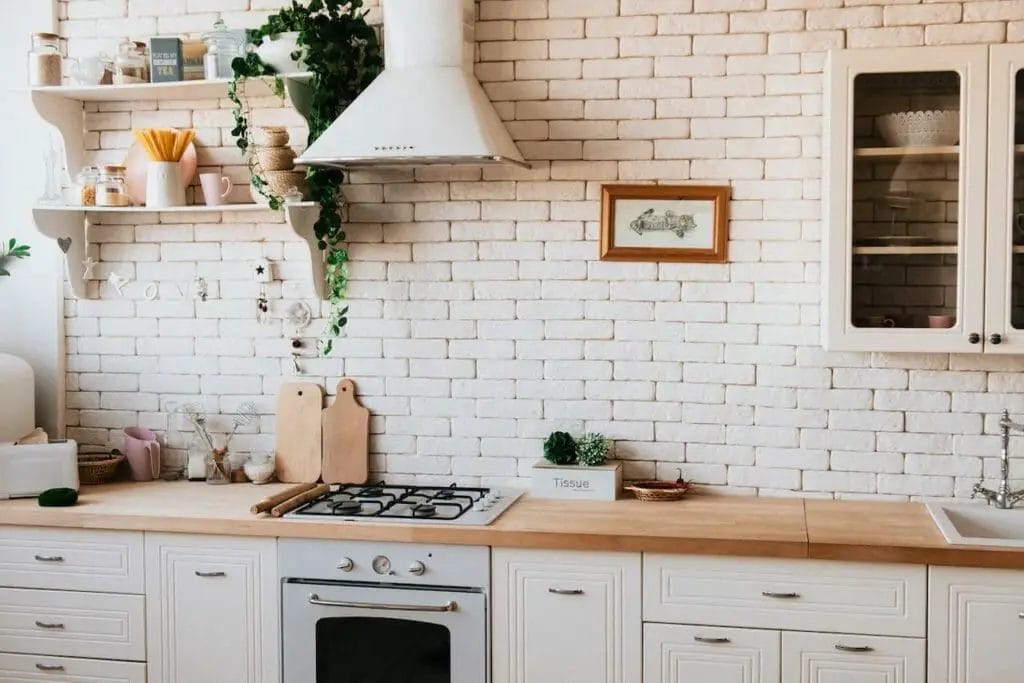
Now you're probably wondering how much it costs to live there?
For a long time , Denmark has been included in the list of the most expensive countries to live in. Sometime in the year 2012, it was adjudged by some observers as the most expensive country in the world. In a more recent listing though, Denmark comes fifth after Switzerland, Norway, Bermuda, and Australia. So is it really expensive to live in Denmark?
Denmark's Sectors with General Higher Price
Based on the many factors that contribute to the computation of the cost of living in a country, Denmark's prices are higher and so with its tax rate. Depending on whose side you are part of, the higher minimum wage rate can be an advantage or disadvantage. Obviously, this benefits the employed sector more than the employer sector.
Healthcare cost for people with no insurance is quite intimidating. Rental cost is likewise quite high compared to other countries and the difference in costs for acquiring daily needs and luxury items are also apparent.
Being a Danish Citizen – Purchasing Power and Benefits
All these however have to be taken in the light of other daily living considerations in Denmark. Because of the strong trade union representation existing in the country, workers have the benefit of higher wages. Higher wages of course mean increased ability to live comfortably in spite of the higher cost of living.
The higher tax rate redounds to the benefits of citizens and permanent residents through generous welfare benefit packages. Gaining citizenship and permanent residency status in Denmark opens up opportunities for free education and medical assistance.
It is obvious that the high cost of living is balanced by the offered benefits and privileges to citizens and permanent residents. Foreigners therefore who intend to live in Denmark will need to qualify themselves for these benefits. Learn more about Denmark currency.
How to Become a Danish Citizen

Becoming a Danish citizen is attractive to people from around the work. While some go to Denmark just to visit, there are also those that prefer to live and work there for a longer period of time.
Those who are residing or working in Denmark have an opportunity to become Danish citizens should they wish to do so later on. However unlike in other countries that allow dual citizenship, Denmark forbids this. In other words, applicants in this Nordic country will only be able to choose the Danish nationality if they’re bent on staying for good and give up their former nationality.
On the other hand, it should be understood that a child born in Denmark does not automatically acquire the Danish nationality. This is only possible if either the mother or the father is Danish. For Danes who give birth abroad, they will still have to apply for Danish citizenship by naturalization.
Becoming a Danish Citizen Through Adoption
For children under the age of 12, another way to gain Danish nationality is through an adoption order. This applies to foreign children below the age of 12 years old. An important condition, though, is that one of the adopting parents should be a Danish national.
For older children such those who have reached the age of 18, they can already apply for citizenship on their own. Those younger should apply together with either one of their parents.
Read more about how international adoption works in Denmark.
Danish Citizenship By Naturalization
If you live in Denmark for a long period of time, you may become a Danish citizen by naturalization. To be eligibile, you must have a permanent residence permit for Denmark and you must have lived in Denmark for nine years continuously.
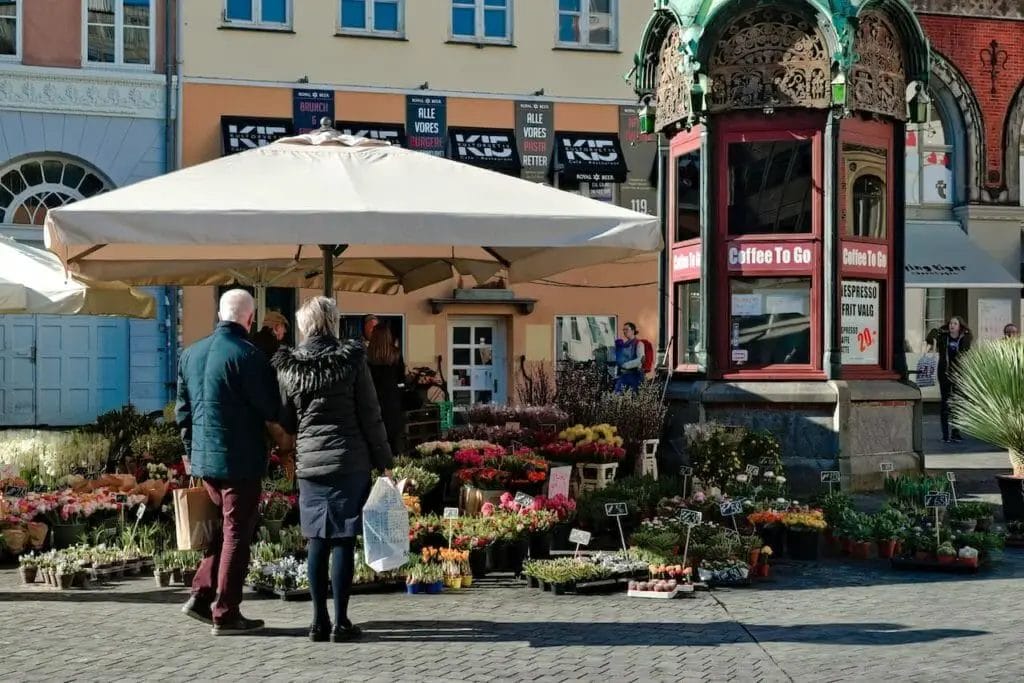
Facts about Living in Denmark – How to process to be a Permanent Inhabitant
The process of becoming a Danish citizen is long and requires thorough information and commitment from the applicant. For example, you have to sign a declaration in which you swear allegiance and loyalty to Denmark and declare your willingness to observe Danish legislation and respect fundamental Danish principles of law.
Another requirement is that you are self-supporting and have not received social or public assistance for more than six months over the last five years.
Finally, before you are granted Danish citizenship, you have to prove your Danish skills by presenting a particular certification. You also have prove your knowledge of the Danish society and of Danish culture and history by passing a specific citizenship test, which is normally held twice a year.
Application Process Duration
The application process normally takes 18 months. It then takes another 3 months for you to get listed in a bill that should be considered by the Parliament. Once your application for citizenship is processed, a letter will be sent to you with the information of your being listed in the naturalization bill.
It is then the Parliament that makes the decision whether to approve an applicant’s Danish nationality. Naturalization bills are normally presented to the Danish Parliament two times every year specifically in the months of April and October only.
Work-Life Balance in Denmark
Much has already been said about how extremely positive it is to be living in Denmark. One of the primary reasons why this is so is the huge importance given to maintaining healthy work-life balance. This means giving equal importance to how people lead happy personal lives while providing security and fulfillment in their work environment.
Not surprisingly, Denmark leads in the list of countries which provide the best work-life balance. Thanks to the very generous social safety net provided in the country, Danes have much less to complain about than their counterparts in other parts of the world. The Organization for Economic Co-operation and Development or OECD undertook the task of determining what countries were included in the list.
OECD based its ranking on at least 3 variables including percentage of employees working very long hours, employment rate for women and children, and the time spent on leisure and personal care. The last variable include the time time spent on sleeping. In these three variables, Denmark managed to get favorable feedback.
The average working hours of Danes are much lower than the established OECD average. Overtime, when rendered, is appropriately compensated. Danes allot at least 16 hours of their day to leisure and personal care. Danish mothers also have better employment opportunities.
Employees are given ample vacation time while provided liberal allowances in the form of sick leaves when an immediate family member is sick. The high degree of flexibility that characterizes Danish life is being credited for the high rate of satisfaction that Danes enjoy.
Living in Denmark – Bucket List
Many people have a travel bucket list: taking part in La Tomatina, visiting the Grand Canyon or just going on a hot-air balloon ride. Whether you enjoy events, food, nature, culture, or just really amazing experiences, living in Denmark has something to add to your list.

1. Living in Denmark, eat local food
Wherever you go in Denmark, you’re going to find irresistible food, from the famous “open-faced sandwich”, the best smørrebrød in Denmark, to lesser-known sweet treats such as flødeboller (chocolate-covered marshmallows, with a base of wafer or marzipan) or kanelsnurrer (a knot-shaped cinnamon bun), not to mention all of the other Danish pastries.
Copenhagen has, of course, a myriad of options for dining out and sampling the best of local cuisine. The street food stalls are a great place to grab a tasty bite as you’re exploring the city, or you could go to Pølsevogn Papirøen, Copenhagen’s street food market.
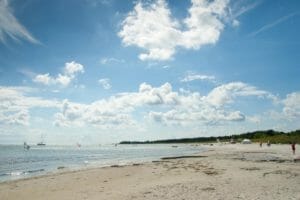
2. Visit a Danish beach
With its low elevation and miles of coastline, there are plenty to choose from. One of the most popular is Lokken Beach, in North Jutland. The expanse of white sand, with traditional beach huts and dotted with World War 2 bunkers, has both history and scenery. There’s fresh fish, local brews, and water sports – everything you could wish for from a beach. See how to enjoy a beach holiday here.

3. Visit nature
For nature spotting, enjoying the view or stretching your legs in the fresh air, Denmark’s national parks – Thy National Park, Mols Bjerge National Park, Skjoldungernes Land National Park and Wadden Sea National Park – have it covered. The last of these is on the UNESCO World Heritage list, and is Denmark’s largest. It’s part of a combined effort with Germany and the Netherlands to protect the world's largest area of intertidal sand and mud flats.
It’s a haven for birdwatchers (and seal watchers!), who might also be interested in Lille Vildmose, a raised bog that provides the habitat for golden eagles, as well as aurochs and deer (plan your Deer Park Copenhagen visit). It’s conveniently located for anyone planning to visit Lokken Beach (see #2).
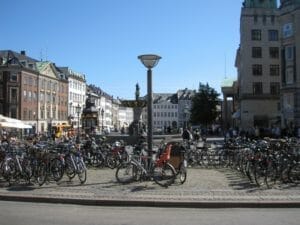
4. Living in Denmark, cycle around Copenhagen
There are many bike lanes and bike paths around the city, and it’s no wonder: there are more bikes than inhabitants, and most cycle 1.5km a day. It’s easy to hire one from the public bike share, Bycyklen, and you’ll soon feel like a local as you ride around on the intelligent, electric bikes. Bike in Denmark is a must!
You can join a complete city bike tour around Copenhagen here. Or discover especially Norrebro district by bike (book here), a great multicultural area there!
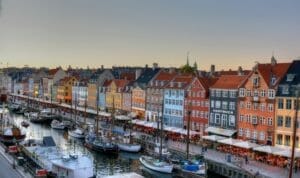
5. Do the Hans Christian Andersen tour
One of Denmark’s most famous citizens, this author has left his mark across the country. Born in Odense, there you can visit his former house, now part of a museum; in winter the town holds an old-fashioned, Hans Christian Andersen Christmas Market. Later in life, he moved to Copenhagen, where he lived in various houses in the colourful Nyhavn. A 20-minute walk further along the coast will bring you to the iconic Little Mermaid statue. He also went to Tivoli Gardens many times (see #6).

6. Tivoli Gardens
Tivoli Gardens Copenhagen is a mus-visit amusement park and pleasure garden. Said to have been Walt Disney’s inspiration, it has many of the features that Disneyland is known for – areas styled after distant countries, summer fireworks, restaurants, and huge celebrations when the park is decked out for Halloween and Christmas. It combines the old, such as one of the world’s oldest wooden roller coasters, with new and thrilling rides featuring virtual reality. During its main season, from May to September, it holds an ongoing music festival with performances in multiple genres, including classical, opera, rock, and pop. There’s literally something for everyone.
You can get your skip the line ticket online here.

7. Northern Lights
Although Denmark doesn’t get the best coverage of the Aurora Borealis, it does have some of the most colourful displays in the hemisphere. To see them, you’ll need to go to the north of the country – the Faroe Islands are a popular choice. You can check the Aurora Forecast online, which is reasonably accurate up to an hour in advance.

8. Christiansborg Palace
On the islet of Slotsholmen stands Denmark’s second-most visited palace, which is the only building in the world that houses all three branches of government – the Danish Parliament Folketinget, the Supreme Court, and the Ministry of State. The Queen also uses parts of the Palace, for example when receiving foreign ambassadors. A climb up the tower is free, but the entrance fee will allow you inside, to view the grand rooms and the tapestries that show 1000 years of Danish history. In the grounds, you can see the ruins of castles that previously stood on the island: Bishop Absalon's Castle and Copenhagen Castle. There are many other Denmark Castles you must visit too!
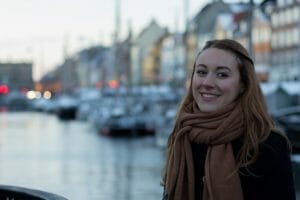
9. Living in Denmark, meet locals
Here's why Denmark is the best place to live. There’s no better way to get to know a place than to talk with the people who live there, and with the Meet the Danes scheme, you can. Visit a local in their home and enjoy leisurely conversation over a home-cooked meal – you’ll experience true Danish culture.

10. Visit Bornholm
Take a trip to the charming Bornholm for a taste of Danish island life. The largest town, Rønne, has more white, sandy beaches, markets, and a herring smokehouse, while you can see some of its history in the traditional mill and distinctive round churches. More culture can be found at the Hammerhus fortress ruins and the lighthouse, after which you can buy yourself a refreshing ice-cream.
These are just some of Denmark’s highlights – there are plenty more that you could add to your bucket list. For many more things to see and do to have a great time, why don’t you check out our summer holiday list?
Survival Guide for going to and Living in Denmark

What do you need to know before going to Denmark? Whether you are moving there for good or simply going for a short trip, you must have a lot of questions in your mind. From the clothes you need to bring with you to the food you should expect to eat, knowing all these will make sure that you survive your trip to Denmark no matter how long it will be. Here are the top questions and the answers to them about life and living in Denmark:
What clothes should I prepare?
Layers are your best option when it comes to dealing with Denmark weather. Their conditions can be confusing. One minute you are freezing then a few minutes after the weather will be scorching hot. Give yourself enough sweaters to survive. You will need to include what Danish people call “rain clothes” too. The Danish summer is surprisingly cold and rainy. Remember to pack in a lot of sweaters. They will be perfect for any weather condition in Denmark.
How can I make friends in Denmark?
Perhaps it is one of the best things about going to Denmark. You don’t have to worry about language barrier because more than half of the entire population speak English very well. Though it is a relatively small country, the people in Denmark are very open to welcoming tourists in their place. They may seem reserved in the beginning, but they can be very friendly and accommodating once they get to know you. Here's more info on how to make friends in Denmark.
What should I buy to give to the people I love back home?
If you are only taking a short trip to Denmark for vacation, you must not forget to bring home housewares. Yes, you read it right. Your mother will surely love a Royal Copenhagen tea set and you’re going to get it for her for half the price. There are many beautiful home textiles made in Denmark. It only shows how much Danish value home and family.
Living in Denmark as a Family – Is Denmark a good place to live?

Allotment Gardening in Denmark
Allotment gardening or community gardening has long been very popular in Denmark. The first known allotment gardens in the country were the ones laid down along the Fredericia fortifications in 1778. The first private initiative for allotment gardening was seen in Aalborg and Copenhagen.
Urban Living in Denmark – How to go Green
Through time, many people transferred from rural to urban living. Since most people were accustomed to country living and self-sufficiency, moving to the city awakened the longing to cultivate land and produce vegetables and fruits. This led to the rise of allotment gardening amidst the many constructed buildings in the city. It was a chance to be near soil again and be able to produce one's own food as many were accustomed to.
As more Danes became accustomed to a new way of affluence and official holidays were introduced by law, allotment gardens for many became the default summer house for numerous families. This meant being able to stay in designated allotment lots for several months in a year for some sort of vacation. Allotment gardens are usually managed by allotment associations to ensure order. Municipalities often rent out land for this purpose to allotment associations.

Allotment Gardening – How it works
At present, the Allotment Garden Federation of Denmark regulates most allotment associations in the country. Rules were clearly established to prevent private entities from unduly profiting from the use of public land. With this in place, Danes gained access to allotment gardening for leisure. It is worth noting that allotment gardens are situated in the most attractive plots of land. This has led to a long waiting list for membership application in allotment associations.
Now, what other questions do you have in mind on what's it like to live in Denmark?

Be the first to comment